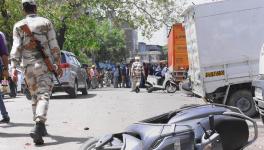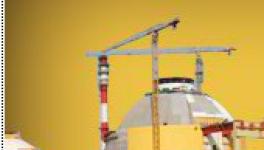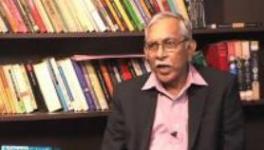Hot Steel and a Cold Government
The near fatal radiation exposure in the Mayapuri scrap has led to hospitalisation of 11 people – one of whom died later on. The cause has now been identified as radioactive cobalt 60 sources that were mixed up in the scrap. What neither the Atomic Energy Commission nor the Government has disclosed is that it is not the first time that we have found radioactive cobalt 60 in metal scrap. Almost two years back, Germany reported finding radioactive steel coming from India. The French followed with reports of radioactive buttons in elevators originating from radioactive steel, again from India. It is amazing that even after this and known dangers to the people who would be inadvertently exposed to high radiation, the Government of India and its agencies took no steps regarding the prevention of such incidents. Neither do we have any clarity on how such incidents have occurred or from where the offending radioactive material originated.
The Atomic Energy Commission, the keeper of the nation's nuclear safety has virtually washed its hands off the affair, claiming that the radiation material appears to have originated from imported scrap and AEC had no responsibility regarding this. This is what Prithviraj Chavan has also echoed in the Parliament. What this shows is the utter callousness with which the Government authorities conduct their nuclear affairs. To add gratuitous insult to radiation injury, Prithviraj Chavan tried to relate it to the Nuclear Liability Bill pending in the Parliament – apparently this bill has provisions relating to radiation damage from scrap. The truth is that the Nuclear Liability Bill covers only nuclear reactors, and the last we know, there are none in Mayapuri!
Now it transpires that the radioactive material originated from the Delhi University Chemistry Department, which had disposed of as scrap a gamma radiation equipment with an active source of cobalt 60. Therefore, this falls squarely within AERB/AEC's jurisdiction, as they are supposed to track all radioactive sources in the country.
The story of radioactive scrap is not new. In August 2008, a container from India containing bars of steel to be sent forward to Russia, was detected by port authorities in Hamburg to have very high radioactivity levels. In one day, the radioactivity level was equal to what is a safe dosage for a year. Neither was this an isolated incident. According the Spiegel Online International (Finds of Radioactive Steel on the Rise in Germany, Christian Schwägerl, 02/16/2009), “For months, similar cases have been found across Germany, all involving bits of metal contaminated with radioactive cobalt. And most of them come from the same source: three steelworks in India, in particular a company called Vipras Casting, based in Mumbai”. Later reports indicated that apart from Vipras Casting, there were another five companies involved. They were Bunts, Laxmi Steels, SMK Steels, Pradeep Metals, Goradia Special Steels Ltd.
The Atomic Energy Commission and the Atomic Energy Regulatory Board (AERB) has total responsibility in the country for all such matters. Satya Pal Agarwal, head of the radiological safety division of India’s Atomic Energy Regulatory Board stated at that time that AERB was tracking the whole supply chain. We have yet to hear what happened after the supply chain was “tracked”. Instead, we exactly similar sounding statements emanating from AERB. The only grudging additional information given is that scanners are supposed to be installed in all the ports, which are lagging behind. No details of what are the steps that AEC or AERB took after the last round of radioactive contamination was reported.
The issue is clear. Radioactive material is mixed up in scrap – either imported or local -- and finding its way into steel making. Obviously, iron and steel scrap is used extensively in India and elsewhere for making steel. This steel is not only exported but also finds its way into domestically manufactured engineering goods. This is the danger – such “hot” steel is circulating in India already and the Government is taking no steps regarding such danger to its people. If more than 150 tonnes of steel have been reported to have such radioactive contamination, how much is circulating here? It would be foolish to think that only exported steel has been contaminated and not domestic manufacture.
In today's day and age, peoples lives are assumed to have less importance than the value of our exports. Obviously, if the steel used in engineering industry gets contaminated, this poses a huge risk for our 23 billion dollar exports in this sector. If not for the health of its people, at least for protecting its industry and its exports, we would have expected the Indian Government to carry out an aggressive program with respect to import of suspect iron and steel scrap. Yet, after almost 2 years, we find that the scanners and radiation measuring instruments to monitor imported scrap is yet to be functional in our ports. The Government has passed the buck to the steel makers telling them that they must check for radioactive contamination of all their inputs.
In a statement to the press, Dr S Banerjee, Chairman of the Atomic Energy Commission said , "Whatever happened in Delhi had nothing to do with the activities of my department. The scrap materials come from other countries and it was not possible for the Department of Atomic Energy to check at the entry points if there were any radioactive materials in them. Checking all the containers laden with scrap was not possible. Instead, scanning could be done. While a decision to install scanners had been taken, implementation was taking time." This statement makes clear – according to AEC – they are not responsible for radioactive material if it is mixed up in imported scrap. According to Dr. A Goplakrishnan, former Chairman, AERB, AEC Chairman's position is not in conformity with the constitutional responsibilities that AEC and its subordinate institutions have. Under the country's law – the Atomic Energy Act of 1962, it is their responsibility and this is an attempt by AEC and AERB to evade their legal responsibilities. If we take into account that AEC and AERB have been fully aware of the risk of imported radioactive scrap, their evasion of responsibilities becomes even more glaring.
As Dr. Gopalkrishnan points out, the Act's sections 16 and 17 makes clear that monitoring all such possible radioactive substances is a part of AEC's duties. Subsequently, Atomic Energy Regulatory Board was set up in 1983 and this part of the mandate was transferred to AERB. Dr. Gopalkrishnan points out, “One of the responsibilities legally assigned to the AERB through its founding notification is to review operational experience in the light of the radiological safety criteria recommended by the International Commission on Radiological Protection (ICRP), International Atomic Energy Agency (IAEA) and other similar international bodies, adapt them to suit Indian conditions, and thereby evolve major safety policies.
This aspect is especially relevant in dealing with issues of missing and misplaced powerful radioactive sources, a subject in which IAEA has enormous experience and data bases. IAEA has also, over the years, developed procedures for preventive and corrective action, in consultation with various countries. After evolving appropriate national policies based on this world experience, the AERB is to implement them and maintain a high degree of nuclear safety and security in the country”.
The AEC Chairman cannot wish away the statutory obligations that the Act imposed on AEC. In fact, the radioactive steel cases in Europe were all dealt with their respective nuclear agencies who also put in place the measures to prevent such occurrences as well as the safe disposal of the radioactive steel. Contrast this with India, where the steel company was told to bury the 21 tonnes of radioactive steel in its premises. The company also complained that AERB was not very cooperative on this question.
One of the advantage of radioactive contamination for post mortem purposes is that it does leave a physical trace. The people are entitled to ask what happened last time when AEC/AERB traced the path of radioactive scrap going into steel plants? Is it the same source that caused the problem last time that is responsible now also for the Mayapuri incident or is it a new source? Where did the scrap originate last time and what are the steps that AEC/AERB took then? None of these questions have been answered and given AEC/AERB's record of opaque functioning and stonewalling all questions of safety, none may materialise. India is already offering itself as a hazardous dumping centre to the world. Ship-breaking in Alang has come under the repeated scanner of environmental groups. It now seems with its lackadaisical attitude to radioactive waste and failure to install scanners even after two years of such known cases of dumping, we are signalling a window of opportunity for unscrupulous nuclear waste disposal companies abroad. Come and dump your radioactive cobalt here, we will take some more time before we can even monitor such shipments. The Delhi University case also shows that AERB needs to strengthen its monitoring and tracking of all radioactive sources. Sadly, the response from AERB and AEC does not show and increased awareness of this. This is what we need to rectify to avoid more such incidents.
Get the latest reports & analysis with people's perspective on Protests, movements & deep analytical videos, discussions of the current affairs in your Telegram app. Subscribe to NewsClick's Telegram channel & get Real-Time updates on stories, as they get published on our website.
























